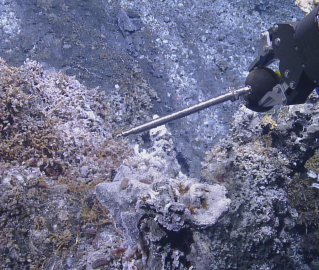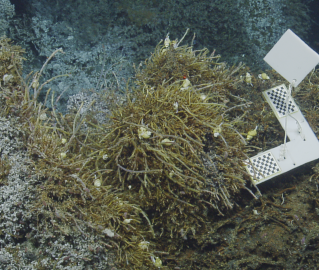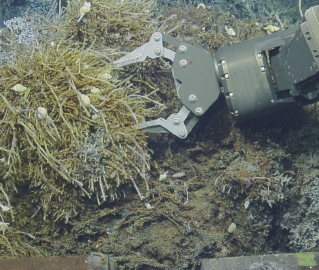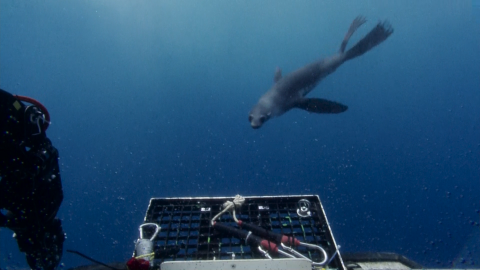#FriendShips
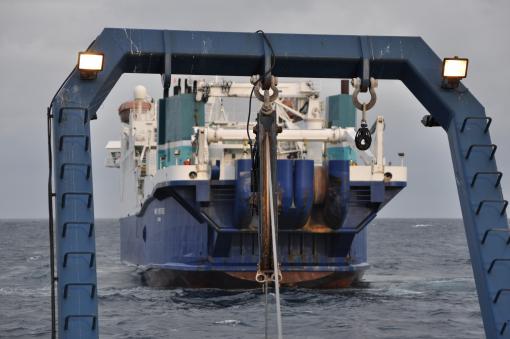
Contributed by Science Communication Fellows Elizabeth Fahy, Timothy Dwyer, DJ Kast and Megan Cook (OET)
E/V Nautilus and C/S Wave Venture work together to restore the world’s largest undersea cabled observatory.
An eleven-foot tall robot and a 10,000-ton cable ship may not be the most likely dancers in a ballet, but during the Ocean Network Canada expedition a highly-choreographed collection of operations between two ROVs and two ships made historic progress installing underwater infrastructure offshore Vancouver Island.
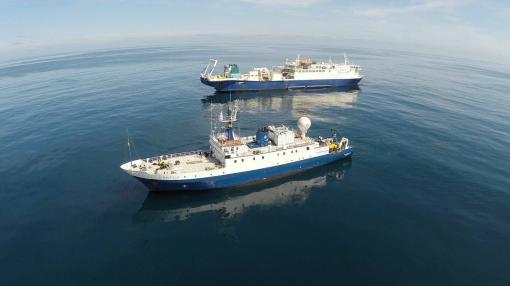
Ocean Networks Canada’s NEPTUNE cabled observatory relies on hundreds of kilometers of fiber optic telecommunication cable to transmit data to shore at the speed of light. The constant power flowing from shore stations bring around the clock discoveries to scientists across the world. E/V Nautilus worked alongside the massive Cable Ship (C/S) Wave Venture over the last two weeks to safely and successfully install over 18 kilometers of new cable. The process of laying cable onto the seafloor, around complex seafloor terrain, more than 2000 meters below the waves, is a challenge that relies on clear communication and many tools: satellite navigation, radar, dynamic positioning systems, high-resolution mapping, radio communication, telepresence, and sonar navigation to make it all happen.
C/S Wave Venture
At 142 meters (466 feet) long and 19 meters (62 feet) wide, C/S Wave Venture is a massive vessel more than twice as long and twice as wide as Nautilus. It is home to up to 62 crew, and it can remain at sea for 40 days. Wave Venture specializes in installing and repairing telecommunications cables that span the world’s ocean floor. The ship is stationed in Victoria, Canada throughout the year, pre-loaded with various telecommunications companies' proprietary cable types so it can be immediately called into action in the event of outages. Companies contract the ship as a rapid response vessel so disruptions can be quickly repaired and service restored when cables are disturbed by plate movement, volcanic eruptions on the seafloor, or fishing gear.
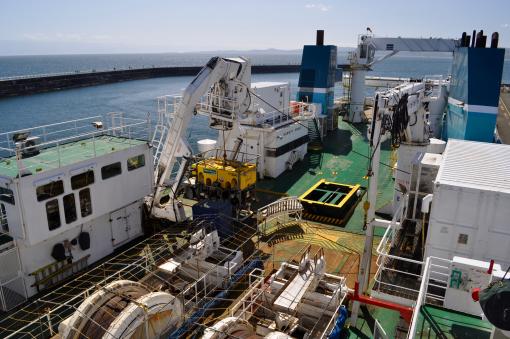
A few members of the Corps of Exploration had the opportunity to tour Wave Venture at the start of the expedition. From its ballfield-sized main cable deck to its cavernous cable wells, everything about the vessel is BIG! The ship lays cable off of its stern by paying it out from one of its three storage tanks, each one large enough to park semi trucks. Cable is run through a circuit of tensioning engines to carefully lower cable in an organized manner out from the vessel as it moves. Contrasting Wave Venture’s monolithic appearance, the steel-armored fiber-optic cable is relatively delicate at only 3.6 centimeters in diameter. The outside protective layer is tar-soaked fabric overtop of stainless steel wire. Insulated under the wire sits the hollow electricity-transmitting copper sheath. The sheath is filled with further insulation to protect the most essential piece of the cable- the 25-micrometer glass fibers (the data-transmitting fiber optics). One of the features that makes Wave Venture especially impressive is the ship and crew’s ability to splice together the nearly microscopic fiber optics of two damaged cable ends while at sea.
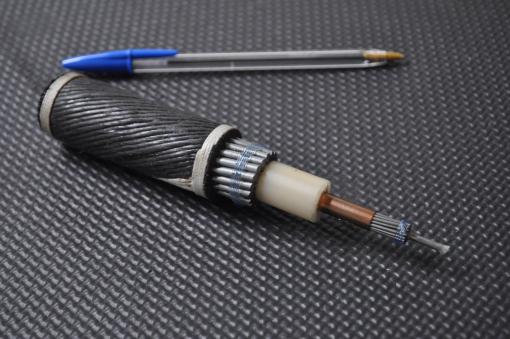
A Team Effort
In the delicate two-ship ballet, Nautilus and Wave Venture worked closely together to install four new telecommunications cables for the NEPTUNE observatory– one at the Clayoquot Slope Node and three at the Endeavour Node. The cable lays at Endeavour are some of the deepest and most challenging sites within the observatory because of the rugged volcanic terrain and towering hydrothermal vents. Each of these cable lays is extremely important and brings new seafloor instrumentation online to expand Ocean Networks Canada’s scientific mission. In some cases, scientists have been waiting for these instruments for nearly a decade.
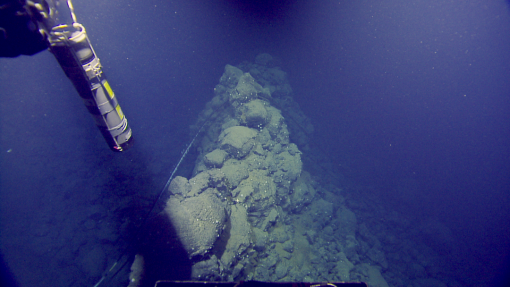
With Wave Venture always within sight of Nautilus – and occasionally closer than 100 meters – the cable ship paid out cable from the stern. Beneath Nautilus the ROVs Hercules and Argus were standing by to supervise the cable lay, watching as the cable made contact with the seafloor. The team in the control van used the ROVs to keep a watchful eye for loops, kinks, or chafe points that could damage, hinder, or destroy the power or telecommunication capabilities of the cable. Hercules carried a navigational beacon called an Ultra-short Baseline (USBL) transponder so both ships could trace the progress of the cable deployment in three dimensions.
One of the largest challenges of working with vehicles so closely is the entanglement risk of lowering cable near the tether of the ROV. Nautilus and Wave Venture used an extensive array of technologies onboard to carry out the operation. The two ships stayed safely in close proximity by using their dynamic positioning systems rather than main engines. Dynamic positioning is a GPS-linked, computer controlled system of thrusters and jet pumps that can move the ships in any direction or hold stationary against the wind and swell. The bridge crews verified distances between ships using radar and communicated continually through VHF radio. In the control van, ROV pilots and navigators tracked the vehicles below using USBL and Doppler navigation. Communication technology was one of the most important tools used in this delicate operation. Using the telepresence technology of Nautilus, cable engineers and crew on Wave Venture were able to join the same conversation viewers around the world were hearing on www.nautiluslive.org.
The operations were deliberate and at times tense, but the successful installation of these cables was a massive success for Ocean Networks Canada and an impressive collaboration between Ocean Networks Canada and the teams aboard Nautilus and Wave Venture. The NEPTUNE observatory supplies power and data connectivity to 140 undersea instruments with 9000 sensors to collect data on physical, chemical, biological, and geological aspects of the ocean over long timeframes. The success of this mission relied on the talented teams involved, years of planning, persistence, and dedication to enabling people around the world live access to the mystery and importance of the unknown ocean.
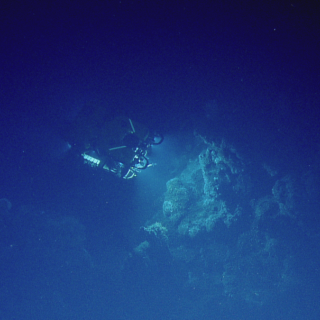
Ocean Networks Canada
E/V Nautilus will begin her second season in the Pacific Ocean exploring Canadian waters with Ocean Networks Canada (ONC). ONC operates world leading cabled ocean observatories that supply continuous power and Internet connectivity to a broad suite of subsea instruments. The ONC observatory installations span one of the widest ranges of ocean environments found anywhere in the world.

